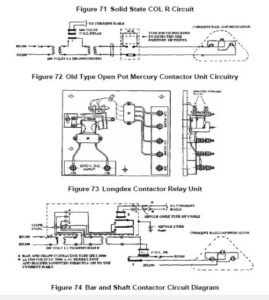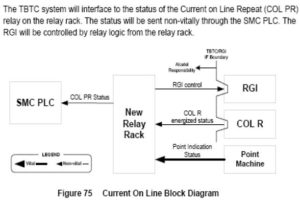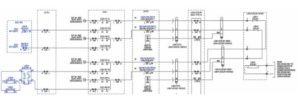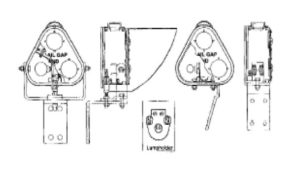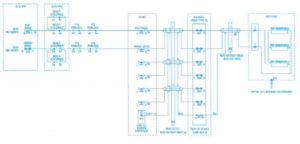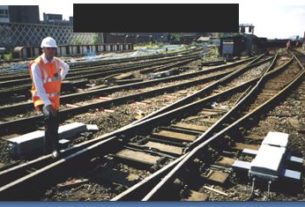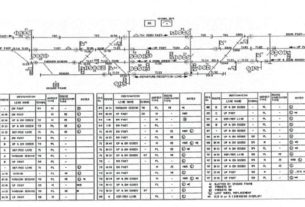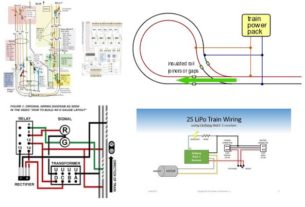CURRENT ON-LINE REPEATERS & RAIL GAP INDICATORS
CURRENT ON-LINE REPEATERS :- Current On Line Relays are used to monitor the state of the traction supply for each traction section.
1. The Relay Rack shall non-vitally monitor the status of the COL R.
2. The Relay Rack shall continuously indicate the status of each COL R to the SMC PLC to enable the SMC to request routes across the gap and/or maintain train position as appropriate.
3. The Relay Rack shall illuminate the rail gap indicator whenever a traction section ahead of the rail gap indicator is de-energised.
4. In areas containing points, the Relay Rack shall illuminate the rail gap indicator whenever the points in advance of the rail gap indicator are positioned such that a train would be routed towards a de-energised traction section.
5. There are four different types of COL relay units in use:
i) Solid state unit type.
ii) Open Mercury pot contactors
iii) Longdex closed mercury switch type
iv) Bar & Shaft type.
6. The principle of operation is same for all types of COLs.
7. Bar & Shaft unit consists of 600V DC solenoid, resistors and contacts for the operation of repeater relay circuits or the direct illumination of a rail gap indicator. The solenoid is wired to the positive and negative conductor rails protected by 600V 1 amp traction fuses.
8. When the traction current switched on the feed from the traction current rails will maintain the solenoid in an energised state and the contacts positions will be open. When traction current goes off the solenoid is de-energised and the contacts are closed.
9. Most of signalling circuits operate on a 100V, 125Hz supply with exeption of the Jubilee Line Extension that operates on 110V 50Hz supply in the existing systems.
10. The Rail Gap Indicator will continue to be operated by existing Current On-Line Relay (COLR). A new repeat of this relay (COLPR) will be created on the relay rack to control the RGI, in conjunction with point detection relays if required in TBTC system.
11. The SMC input will be fed at 24V DC over a contact of the new COLPR.
12. All new COLPRs will be powered at 110V, 50Hz from TBTC SER.
* Refer to below for Current On-Line Repeater circuit through COC
RAIL GAP INDICATORS
* A Rail Gap Indicator is installed at current rail section gaps on crossover points and each substation gap. They can be installed on their own or combined with other signalling equipment to indicate to the train operator that the section ahead is switched off.
* The Rail Gap Indicator consists of three lamps with red lenses in the form of a triangle arrangement on a white enameled front plate with the legend ‘RAIL GAP IND‘ in black letters. When the traction current ahead is switched off these three red aspects are illuminated to warn the train operator not to proceed beyond that point. At some locations, a rail gap repeater is required if the sighting point of the RGI is insufficient. This is of the same construction except with yellow lenses and an enameled yellow plate with the legend ‘RAIL GAP REP’.
* Rail Gap Indicators are controlled from a Current On Line Relay (COL) unit, which has a direct interface with the traction current rails.
* The RGI shall be fed from the relay rack, over the COL PR contacts and appropriate points detection contacts at 110V 50Hz.
* Refer to below for an RGI Circuit:
* Rail Gap Indicators indicate to the Train Operator that traction current has been discharged from the traction current section ahead.
* Rail Gap Indicators are driven based on the Current-on-Line Relays (also called Traction Current Detectors) status for the traction section ahead on the set route and point positions if required. Rail Gap Indicator Failure:
* RGI fails to illuminate but COL working correctly when traction power is absent:
* Trains in AUTO and PROTECTED MANUAL mode will be prevented from entering non-energised area.
* Trains in RESTRICTED MODE will enter non-energised area.

